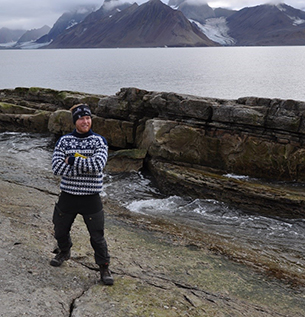Shallow marine systems overlying bedrock unconformities
Josep M. Puig Lopez, PhD candidate, Department of Geology and Petroleum Geology, University of Aberdeen, UK

I am a PhD candidate working at the Department of Geology and Petroleum Geology of the Aberdeen University under the supervision of John Howell and Adrian Hartley. I joined the Suprabasins project on October 2019 and since then I have been working towards a better characterization of the different type of marine systems that develop along rocky shores and the factors that control their occurrence, evolution and preservation. The research conducted has direct applications on the study of structural highs in transgressive contexts with implications for reservoir distribution, specifically, it is being applied to the study of the shallow marine late Jurassic deposits found in the Johan Sverdrup field, in the Utsira High.
I combine different techniques ranging from stratigraphic and sedimentological outcrop and core descriptions, study of modern analogues using satellite and bathymetry images and study of seismic datasets.
Necking domain of the mid-Norwegian Rifted Margin and the central SW Barents Sea

Julie Linnea Gresseth, PhD candidate, Department of Geoscience and Petroleum at NTNU in Trondheim, Norway.
I started my PhD-project in January 2020 at the Department of Geoscience and Petroleum at NTNU in Trondheim. My study areas include the necking domain of the mid-Norwegian Rifted Margin and the central SW Barents Sea. Here I, under the supervision of Dr. Prof. Per Terje Osmundsen (NTNU) and Dr. Gwenn Peron-Pinvidic (NGU) use interpretation of 3D- and 2D seismic reflection data to investigate and discuss the effects of lateral development of extensional detachment faults and the associated 4D evolution of supradetachment basins. My main interests lie in how the effects of detachment fault growth and (potential) lateral linkage interact with those of isostatic rollback to produce complex geometries in the footwall as well as the hangingwall within these spectacular large-magnitude systems.
Deposition and preservation of carbonates in tectonically active regimes: An onshore-offshore correlation (DEPOCIT)
Anders Dahlin, PhD candidate, Department Arctic Geology, UNIS, Svalbard Norway

My PhD project concerns the regional tectonostratigraphic evolution of complex structural highs in Svalbard and the Barents Sea. The purpose of my thesis is to understand the evolution of sedimentary facies and the interplay of erosional processes and depositional patterns of sediments related to tectonic movements at long-lived crustal-scale fault zones. For this I use an onshore-offshore analogue approach. At my two study areas, Hornsund (S. Spitsbergen) and Loppa High (SW. Barents Sea), I focus on the timing of Late Palaeozoic tectonism and its relation to deposition and preservation of mixed siliciclastic-carbonate sediments. Onshore – offshore correlation is done through the comparison of sequence stratigraphic patterns of the studied intervals as well as synthetic seismic modelling to compare depositional patterns with the targeted seismic sequences.
I use a multidisciplinary approach that includes methods such as sedimentary logging, litho-and microfacies analysis, drone-based 3D photogrammetric outcrop models and seismic sequence analysis, seismic modelling, and structural reconstruction modelling.
I am located at UNIS in the Arctic city of Longyearbyen, Svalbard and enrolled as a PhD at UiO, Oslo. I started my PhD as part of the Suprabasins research project in the beginning of 2020